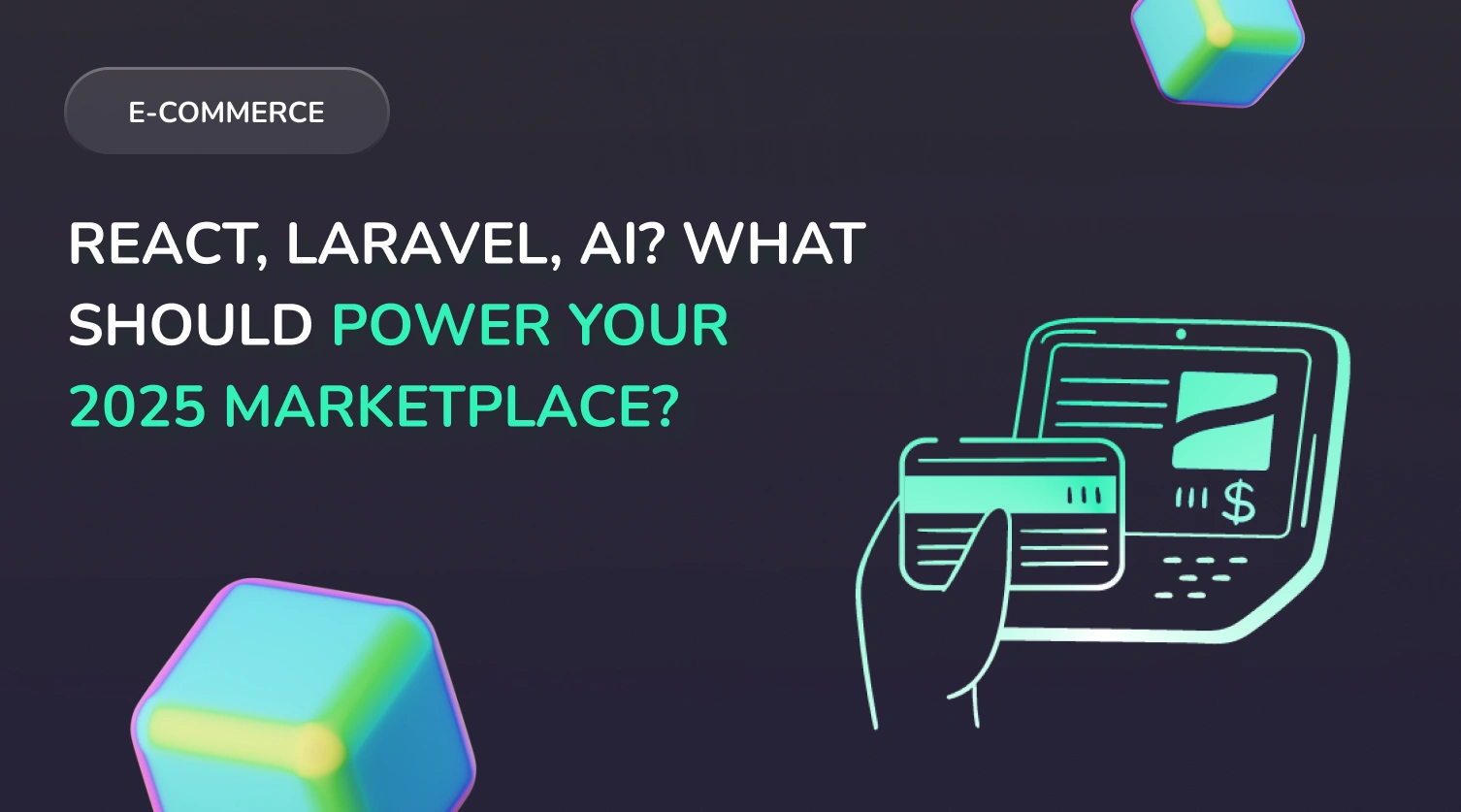
You may have a groundbreaking marketplace idea that could disrupt the market, revolutionize customer experiences, and set new trends in e-commerce. However, the most common pitfall is that even the brightest idea can fail if built on the wrong technology stack. Often, startup founders get discouraged after launching their platform, facing issues like slow loading times, frustrated users, and security gaps. These are the very challenges that put businesses at risk and need immediate attention.
But don’t worry — our digital solutions team for business products knows that technology is the backbone of any booming marketplace. Your job is just to implement it. Want to know what your product needs for effective development? Keep reading this article, where we’ll share the essential technologies that will protect your marketplace, ensuring speed, scalability, and readiness for success.
Top Trends Shaping Marketplaces in 2025
By 2025, when 70% of online purchases are made through mobile devices and AI-driven recommendations dominate consumer behavior, selecting the right tools is not just about functionality but survival and growth. Before choosing the perfect marketplace tech, it’s crucial to understand the trends shaping your product’s market landscape. These trends reflect consumer behavior and emphasize the need for companies to adapt to technological advancements to stay competitive.
1. Hyper-Personalization with AI
Now, consumers expect more than just a list of products; they expect personalization. As we’ve seen, many marketplaces already integrate AI-driven recommendation systems. Companies like Vans use vast customer data to suggest products based on previous purchases, browsing history, and emotional responses.
This level of personalization goes beyond simply recommending products. For companies, the advantage lies in predicting needs, which leads to increased conversion rates and customer satisfaction.
How does this help?
Hyper-personalization boosts customer loyalty, increases engagement, and drives sales. AI allows businesses predict consumer preferences, reducing stock loss by optimizing product recommendations.
2. Social Commerce Boom
Social commerce is more than just hype; it’s a rapidly growing trend that will reach $1 trillion globally this year. Platforms like Instagram, TikTok, and Pinterest have evolved from simple social networks into powerful sales channels. Features like shoppable posts and live product demos allow customers to find, browse, and buy products directly within the app.
Integrating social commerce into your marketplace can help you tap into a younger, tech-savvy audience. This approach reduces friction in the buying process and capitalizes on the growing trend of purchasing directly within social apps. For you, it means expanded reach and increased sales.
3. Omnichannel Experiences
Consumers today expect seamless shopping experiences across all channels. Whether it’s browsing websites on a desktop, making a purchase through a mobile app, or checking out at a store kiosk, businesses must meet customers wherever they are.
Platforms like Adobe Experience Cloud help companies integrate these touchpoints. Omnichannel marketing is not just about being present on different platforms; it’s about creating a unified experience that flows smoothly from one device to another.
In practice, omnichannel strategies ensure customers can interact with your marketplace anytime, anywhere, on their chosen device. This creates convenience, builds a cohesive brand perception, and enhances customer retention and sales.
4. Speed and Convenience
It’s impossible not to notice how fast shopping in digital stores has become. With the rise of mobile payments, instant delivery, and accelerated checkout processes, today’s consumers expect purchases to be fast and easy. A key component of this trend is the “Buy Now, Pay Later” (BNPL) feature, which is expected to become a must-have for businesses. Customers no longer want to wait for lengthy shipping or complicated checkout processes.
Integrating faster checkout processes and various payment options, including BNPL, enhances user convenience. Instant delivery further satisfies the growing demand for ease, especially in e-commerce. For businesses, the advantage of adopting these technologies lies in streamlining logistics and payments, reducing cart abandonment, and improving overall customer satisfaction.
5. Sustainability and Ethical Shopping
As conscious consumers increasingly seek eco-friendly products and brands that align with their values, online marketplaces focusing on sustainability will gain a competitive edge. Features like carbon footprint tracking and ethical supplier sourcing will meet consumer demands and strengthen trust and loyalty. This trend is growing across both the American and European markets, where consumers are becoming more deliberate in their shopping choices.
6. Subscription-Based Models
Subscription services are quickly gaining popularity. From curated product boxes to premium memberships, marketplaces are using this trend to create continuous revenue streams and deepen customer relationships. By leveraging AI and data analytics, you can personalize subscription offers based on consumer preferences, making them more appealing and increasing customer retention.
7. AI-Powered Customer Service
Let’s return to AI for a moment. AI is transforming customer support in marketplaces, reducing time for both your team and customers while serving more clients effectively. AI optimizes processes like chatbots, virtual assistants, and automated troubleshooting. These technologies improve response time and availability, providing customers with fast and efficient 24/7 support.
AI not only enhances user service quality but also helps reduce operational costs, making it a valuable investment for any marketplace looking to scale.
8. AR/VR Integration
Combined with augmented reality (AR) and virtual reality (VR), AI is revolutionizing how consumers interact with products online. These technologies allow customers to visualize how furniture will look in their homes or virtually try on clothes. By bridging the gap between online shopping and in-store experiences, integrating AR/VR features into your marketplace can significantly enhance the shopping experience and improve conversion rates.
Make sure to keep an eye on these trends before your competitors implement them. By staying on top of these trends and integrating them into your business strategy, you will meet consumer expectations and ensure long-term success for your marketplace in a competitive market.
Choosing the Right Technologies for Your Marketplace: A Journey to Success
Let’s imagine you’re building the marketplace of your dreams – one that can grow, scale, and meet the challenges of the digital age. But where do you start? How do you choose technologies to help you launch and thrive in the competitive online marketplace ecosystem?
Below, we’ve gathered the best technologies that will form the foundation of your marketplace. Let’s dive into the details.
Frontend & Backend: Laying the Groundwork for Success
When creating an attractive and smooth user experience, think of the frontend as the storefront of your online marketplace. It’s the first thing your customers interact with, and it should leave a lasting impression.
Frontend (User Experience)
Consider this example: Suppose your buyer visits your website, and within seconds, they’re greeted by a smooth, responsive interface. Tools like React.js or Vue.js help bring this vision to life. These driving forces ensure a seamless, fast, and interactive user experience that customers crave. In fact, 68% of European leading marketplace platforms use these technologies to provide their customers with an exceptional browsing experience. Tailwind CSS adds another layer of magic, making the design responsive but also polished and modern. This combination of frontend technologies ensures that users will want to stick around and explore your marketplace platform.
But the frontend alone is not enough. You need a powerful engine under the hood, and that’s where the backend comes in.
Backend (Business Logic & Scalability)
Think of the backend as the “brain” of the system. It handles everything from user logins to transaction processing. If you need a system that can handle thousands of users simultaneously without slowing down, Node.js is your go-to technology. This technology uses a non-blocking architecture, which can handle multiple requests at once, making it ideal for bustling marketplace tech with high traffic. But what if your marketplace serves customers across Europe?
Then, adhering to data protection rules such as GDPR becomes a top priority. Python/Django is a robust marketplace framework that ensures your platform complies with GDPR, giving you peace of mind when building for the European market. For business owners who want to get started quickly without building everything from scratch, low-code platforms like Bubble can help you launch an MVP (minimum viable product) in record time. This is the perfect option for testing before fully diving into development.
AI & Automation: Unlocking the Power of Smart Marketplaces
With AI and automation, the dream of running without glitches and with minimal human intervention is closer to reality than ever. Here are a few points about AI:
- Machine Learning Algorithms Think of them as your assistant on your marketplace. They analyze buyer data to predict their behavior and personalize the experience. For example, when a shopper visits your marketplace, AI can suggest products based on their browsing history, increasing the chances of a sale. AI also helps with price optimization, ensuring your prices stay competitive, and fraud detection, protecting both your customers and your business.
- Chatbots & Automation: It’s 2 AM, and a potential customer has a question about your product. Instead of waiting for business hours, they interact with a friendly AI chatbot that gives instant responses, much like bots powered by ChatGPT technology. Platforms like Adobe Express take it a step further by offering chatbots that handle customer queries 24/7. With automation handling these tasks, your business will run like clockwork, even while you sleep.
- Predictive Analytics: Want to know which products will be in demand next season? Or what are your customers’ sentiments? Predictive analytics tools like Google Analytics and Natural Language Processing (NLP) models use past data to forecast future trends. This insight lets you stay ahead of competitors by offering products that customers will want before realizing they need them.
Mobile-First Approach: Reaching Customers Where They Are
Your customers are constantly moving in today’s world, and your marketplace needs to be too. This is where a mobile-first approach comes into play.
- Flutter or React Native: These cross-platform mobile development tools are essential if you want your marketplace app to work seamlessly on both iOS and Android devices. Instead of creating separate apps for each platform, you can use these technologies to create a single app that reaches a broader audience with less time and cost in development.
- PWA (Progressive Web Apps): What if your customers don’t want to download an app? PWAs offer almost native app-like experiences directly through the browser. With features like offline access and push notifications, PWAs combine the best of both worlds, offering an app-like experience without downloading anything.
You can build your marketplace ready to compete, scale, and thrive by leveraging the right marketplace development services and technologies. Whether you’re looking for white label marketplace platform solutions, SaaS marketplace software, or marketplace platform providers, choosing the best tools to build a marketplace platform that fits your vision and goals is essential.
Security & Compliance: Building Trust with Your Users
As you build your marketplace, security should always be at your mind. A breach could not only jeopardize user data but also damage your reputation. So, what can you do to protect your customers and your business?
- TLS/SSL Encryption:
The foundation of secure online transactions is TLS/SSL encryption. This ensures that all data shared between your customers and your platform is encrypted and safe from prying eyes. Without it, you risk exposing sensitive customer information to cyber threats. - Blockchain for Payment Security:
You can integrate blockchain-based payment systems into your marketplace for an extra layer of security. This adds transparency and security to transactions, ensuring customers feel safe when purchasing. - GDPR & Cookie-less Advertising:
If you’re targeting European customers, GDPR compliance is a must. Solutions like Utiq (backed by Deutsche Telekom and Vodafone) help you stay compliant while still being able to run effective cookie-less advertising. This means you can continue targeting your customers with personalized ads while respecting their privacy.
By carefully selecting the right technologies, you’re setting the stage for your marketplace’s success. With the right blend of frontend and backend tools, AI-powered innovative features, mobile-first strategies, and robust security measures, your marketplace will meet customer expectations and exceed them, building trust and loyalty.
Go-to-Market Strategies for Your Marketplace: The Road to a Successful Launch
So, the next step is here – you have your dream marketplace idea, you’ve chosen the right marketplace tech, and now it’s time to put your platform in customers’ hands. But how do you ensure a successful launch? The key to success lies in a well-thought-out go-to-market strategy that allows you to test, iterate, and scale your product efficiently. Let’s take a look at some proven strategies to help you succeed.
1. MVP (Minimum Viable Product) First: Testing the Waters
Let’s break down the most common scenario many entrepreneurs face. Many companies spend months developing their online marketplace only to realize that, upon launch, the product doesn’t fully meet customer needs.
However, there’s a simple solution: start by launching an MVP (Minimum Viable Product).
By focusing on delivering only the core features that address the main problem of your customers, you can test the product’s viability before committing to a full-scale launch. This approach minimizes risks, saves money, and allows you to collect valuable user feedback in the early stages.
For example, many successful startups use platforms like WooCommerce or Shopify to quickly launch a basic version of their marketplace platform. These platforms offer ready-made solutions for e-commerce, allowing you to test your idea and start selling without creating your own platform from scratch.
Once you validate your business model and gather feedback from real users, you can move on to more customized development. This iterative approach not only protects you from making excessive investments in a concept that may not work, but it also helps you understand the true needs of your audience.
As you plan to scale your platform, keep in mind the cost of building a marketplace website and consider using a white-label marketplace platform or SaaS marketplace software. This allows you to build your own marketplace quickly while providing flexibility for future growth.
Once your MVP is validated, you’ll be in a better position to build a marketplace platform that meets the specific demands of your users. Plus, consider the advantages of marketplace software as a service, which allows you to integrate the latest online marketplace technology and ensure scalability.
2. Speed-to-Market Matters: Launch Faster, Earn Faster
The faster you get to market, the quicker you can start earning. But how do you speed up the launch process without sacrificing quality? The answer lies in using solutions that streamline development while allowing customization.
Platforms like BigCommerce and Headless CMS solutions are designed to cut development time significantly. BigCommerce, for example, allows you to set up an online marketplace quickly with built-in features like payment gateways and inventory management. Headless CMS takes this further by decoupling the front-end presentation from the back-end content management, giving you the flexibility to create a unique user experience while benefiting from a faster development cycle.
The key here is not to rush the process but to leverage technology that accelerates time-to-market without compromising on what matters: delivering value to your customers. When you get your marketplace up and running quickly, you can build relationships, attract users, and generate revenue without unnecessary delays.
3. Strategic Partnerships & Integrations: Building a Strong Network
The secret to scaling your marketplace efficiently lies in building the right partnerships and integrating the tools your business needs to run smoothly. Think of these partnerships as the “infrastructure” supporting your marketplace and ensuring it operates like a machine.
- Logistics:
One of the most important aspects of running an online marketplace is making sure your products reach customers quickly and reliably. By partnering with leading fulfillment providers like DHL or FedEx, you can ensure smooth and fast deliveries. These providers offer robust APIs that integrate with your marketplace, allowing you to automate shipping, tracking, and returns—saving you time and money. A good logistics partner ensures your customers receive their orders on time, improving customer satisfaction and driving repeat business. - Payment Gateways:
A seamless payment experience is crucial to your marketplace’s success. Consumers want to pay quickly, easily, and securely. Platforms like Stripe, PayPal, and SEPA provide smooth transaction processing and are tailored to specific regions. For instance, Stripe is a favorite in North America, while SEPA is essential for businesses in Europe, offering a streamlined process for cross-border payments. By integrating these payment gateways into your platform, you ensure that your customers have a reliable and secure way to pay, no matter where they are. - Social Media Integration:
Social commerce is booming, and platforms like Instagram and TikTok are now major sales channels. Imagine your customers browsing your marketplace, then seamlessly making purchases directly through their social media feeds. By integrating your marketplace with these platforms, you can capture the attention of millions and boost conversion rates. Social commerce allows you to tap into existing communities, build brand awareness, and drive sales—all from the comfort of your social media accounts.
4. Scaling Beyond the Launch: The Importance of Adaptation
Once you’ve launched and established your marketplace, it’s essential to adapt to the ever-changing needs of your customers and the market. The feedback you gather from your MVP launch and the strategic partnerships you’ve built will provide the foundation for your future growth.
Continuously analyzing user behavior, refining your marketplace features, and adding new functionalities, such as advanced AI-powered recommendations or automated marketing tools, will help keep your marketplace fresh and competitive. As you scale, the goal should be constantly improve the customer experience and make the purchasing process as frictionless as possible.
Additionally, expanding your marketing efforts, integrating with more fulfillment partners, and adding features that cater to specific customer segments (such as international shipping or local payment options) will allow you to broaden your marketplace’s reach and appeal to a broader audience.
You lay the groundwork for a successful launch and a sustainable, scalable marketplace by focusing on MVP development, speed-to-market, and strategic partnerships. Each step is about reducing risk, learning from real users, and optimizing your platform for growth. As you continue to adapt and refine your business strategy, you’ll find that your marketplace doesn’t just survive — it thrives.
The Importance of Expertise: Why You Need a Partner Like Corpsoft Solutions
While it’s tempting to take on the development process internally or choose the cheapest option, the reality is that building a marketplace is a complex, ongoing endeavor. If you want to ensure the long-term success of your platform, you need a partner with deep expertise and experience in digital solutions development. This is where Corpsoft Solutions comes in.
With over 7 years of experience in the field, Corpsoft Solutions has worked with many businesses to develop custom digital solutions that meet and exceed expectations. Our team’s expertise spans various industries, allowing them to offer tailored strategies for every stage of the development process, whether you’re in the ideation phase or scaling your marketplace for international growth.
Corpsoft Solutions understands the intricacies of building a marketplace from the ground up. They offer more than just a development team — they offer a partnership that ensures your platform is built with the right technologies, scalable infrastructure, and security in mind.
Wrapping up
The key to marketplace success lies in flexibility, innovation, and the right technology stack. Whether it’s AI-driven personalization, scalable cloud solutions, or mobile-first design, the right choices today will define your success tomorrow.
Want to build the next big marketplace? Make the right tech decisions, and who knows — you could be the next Amazon in your niche.
Subscribe to our blog

